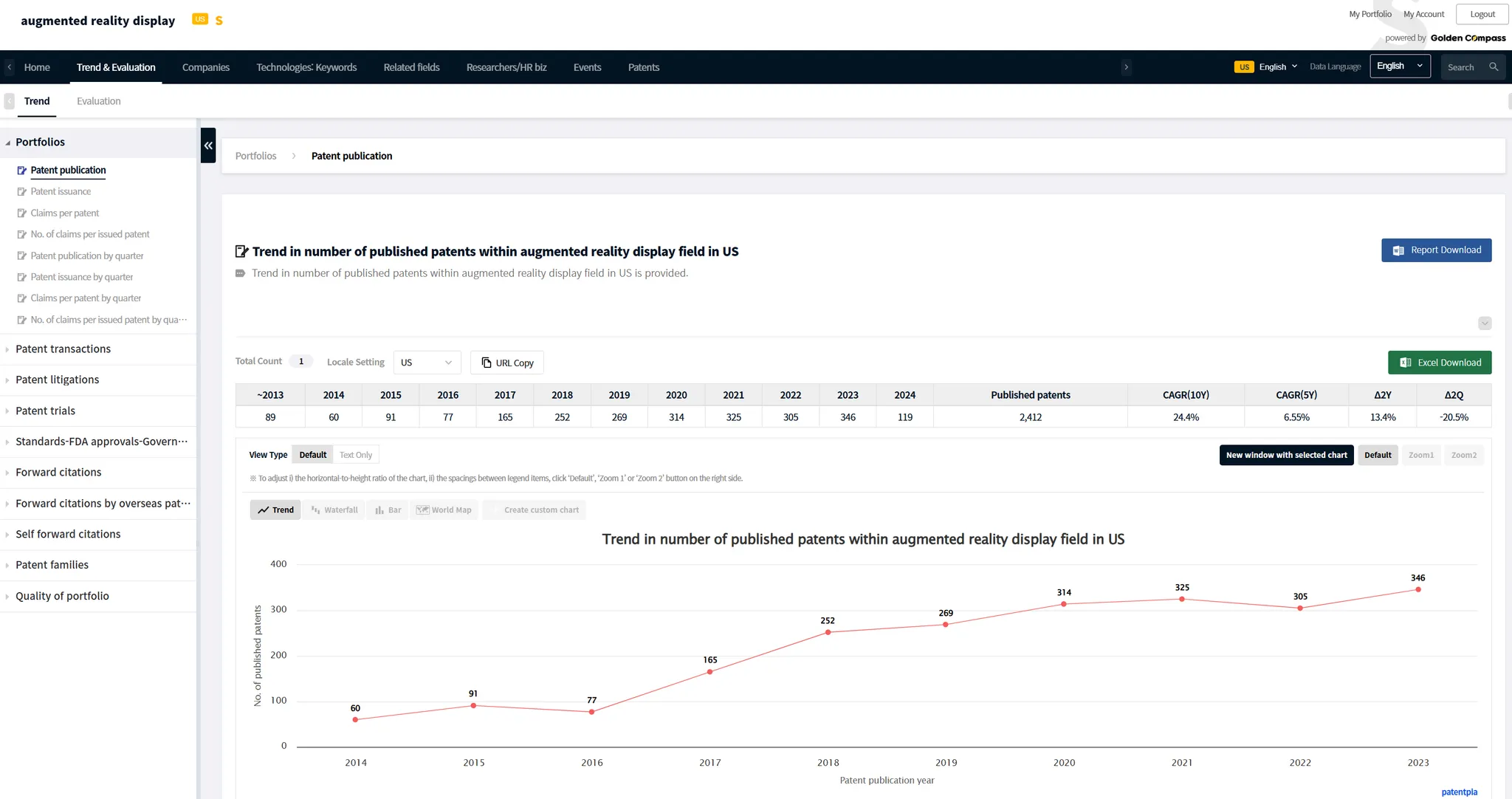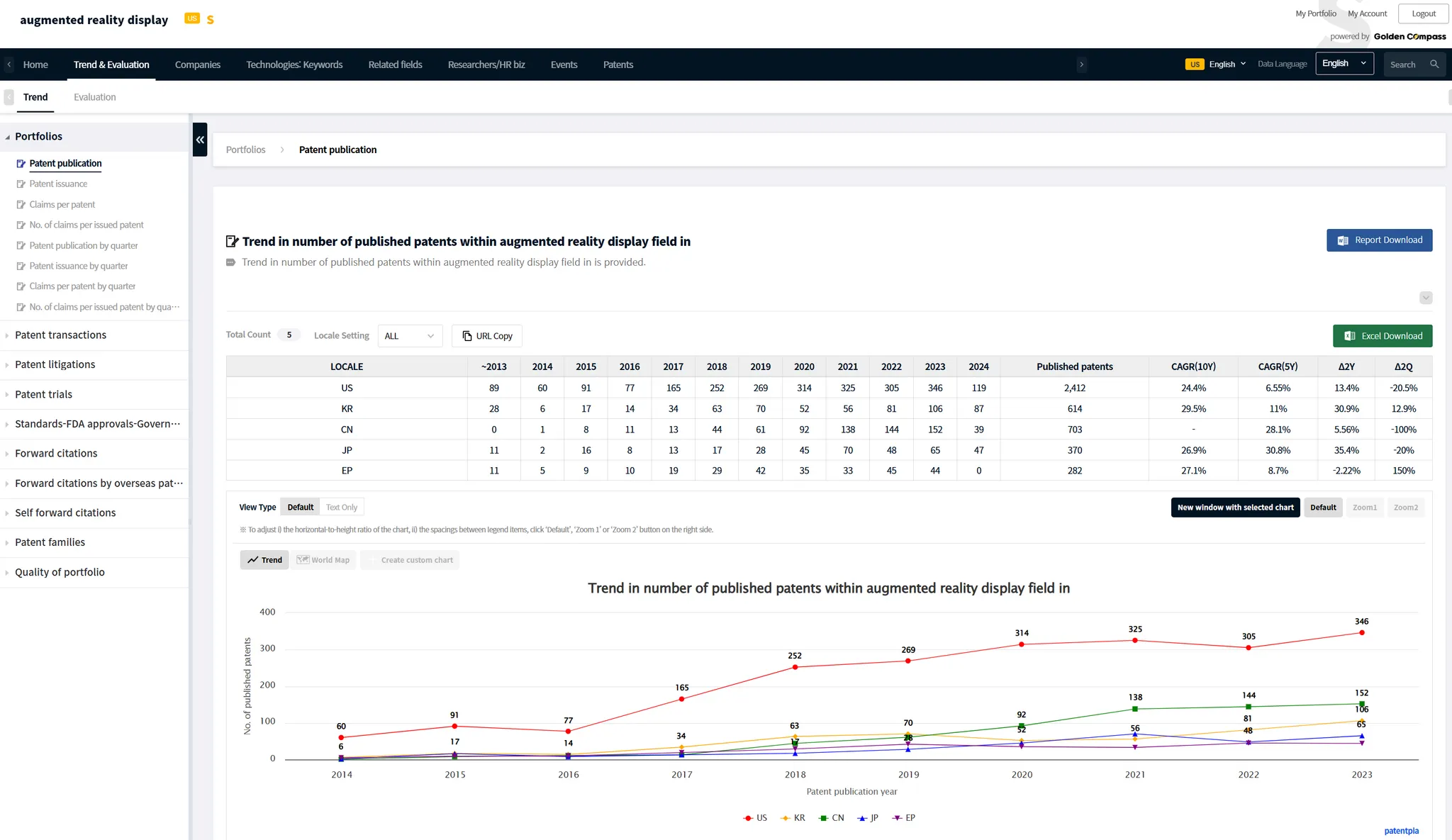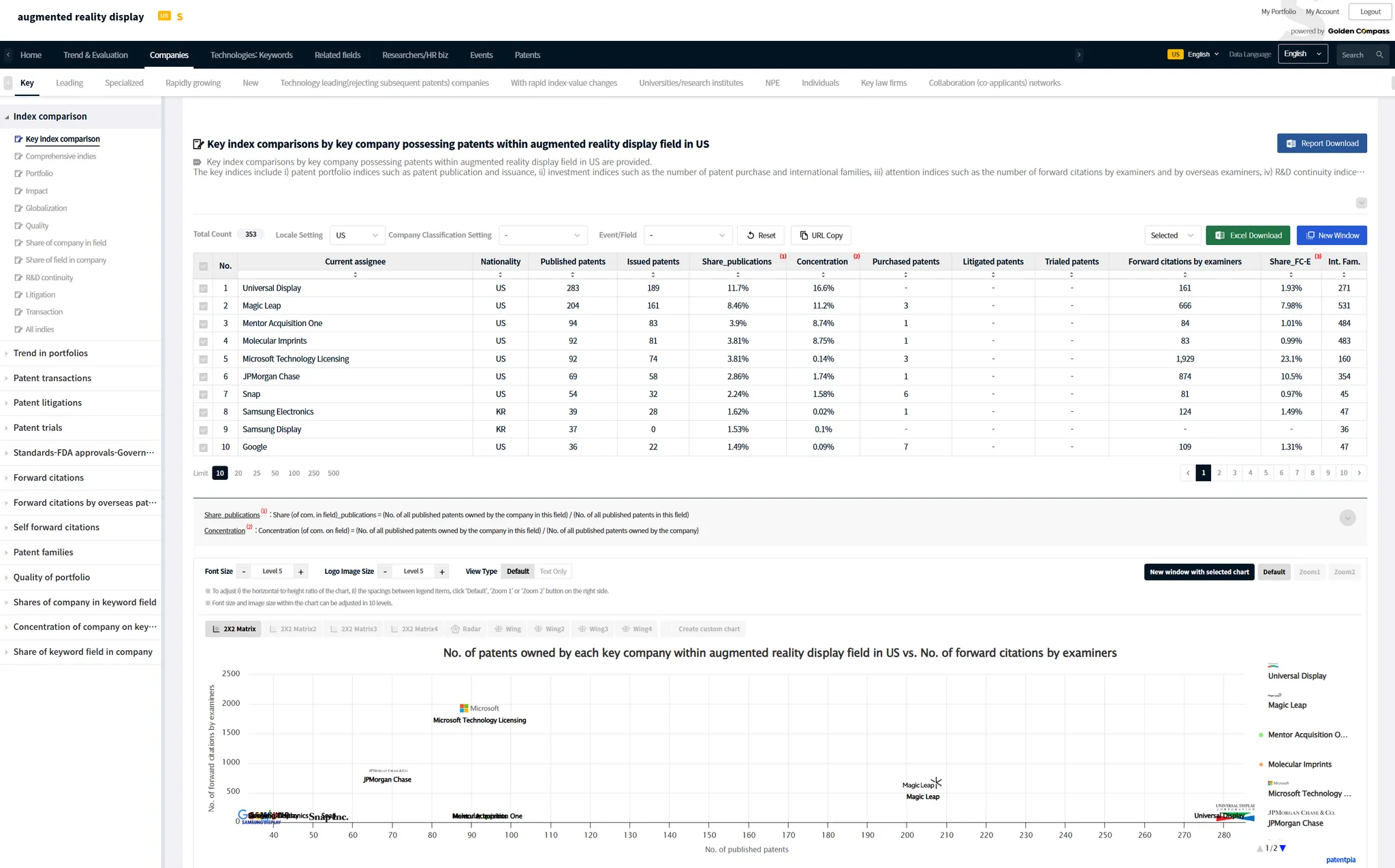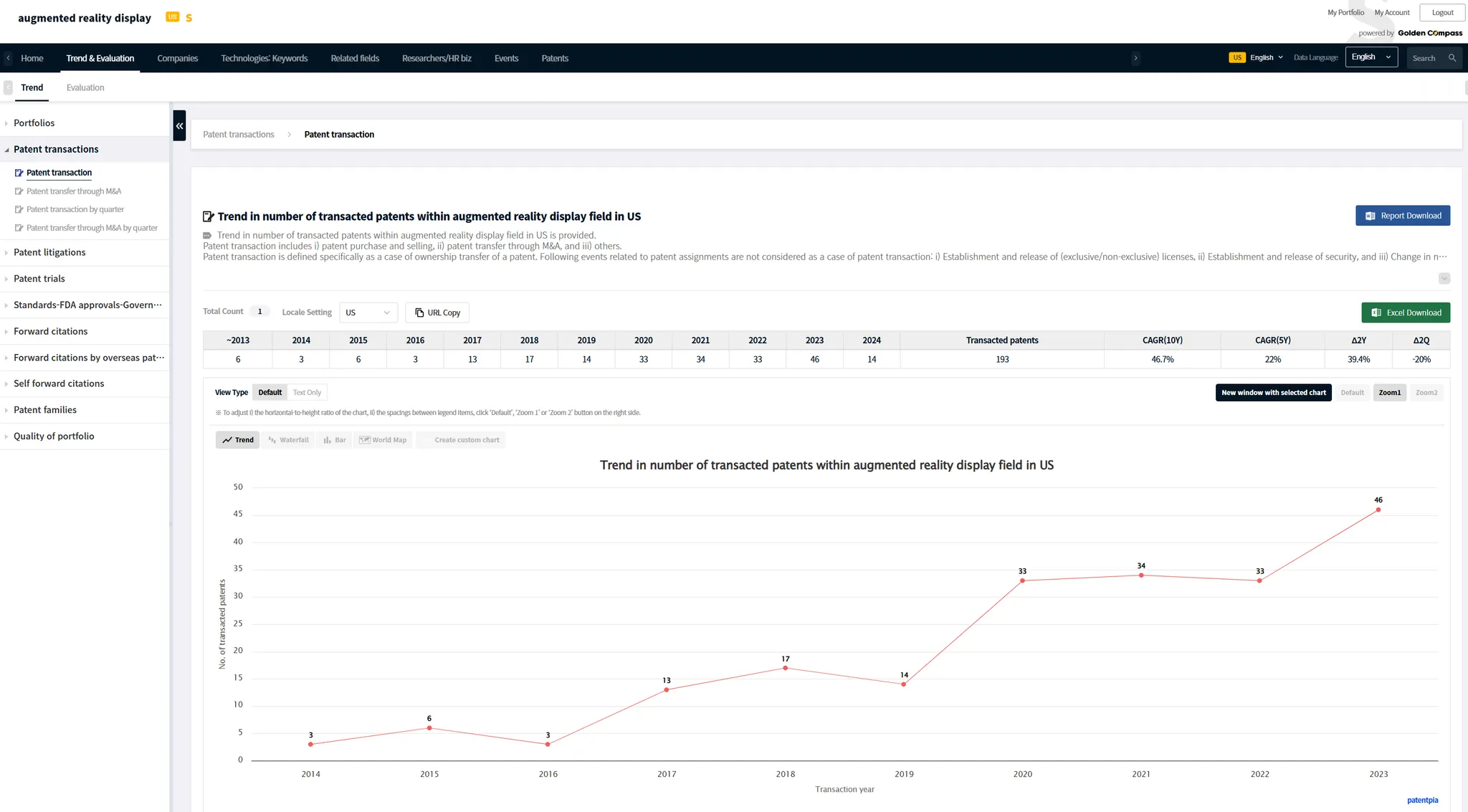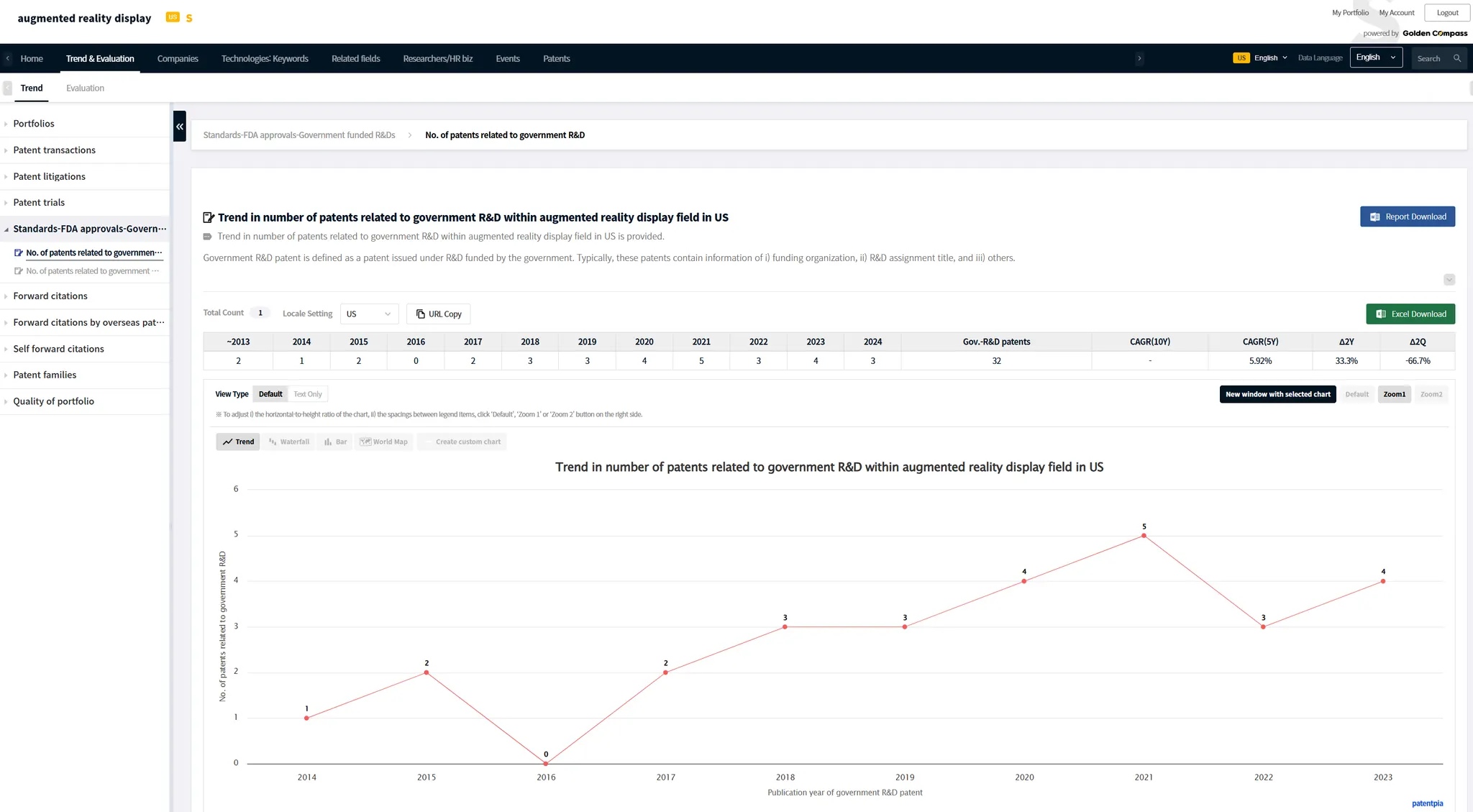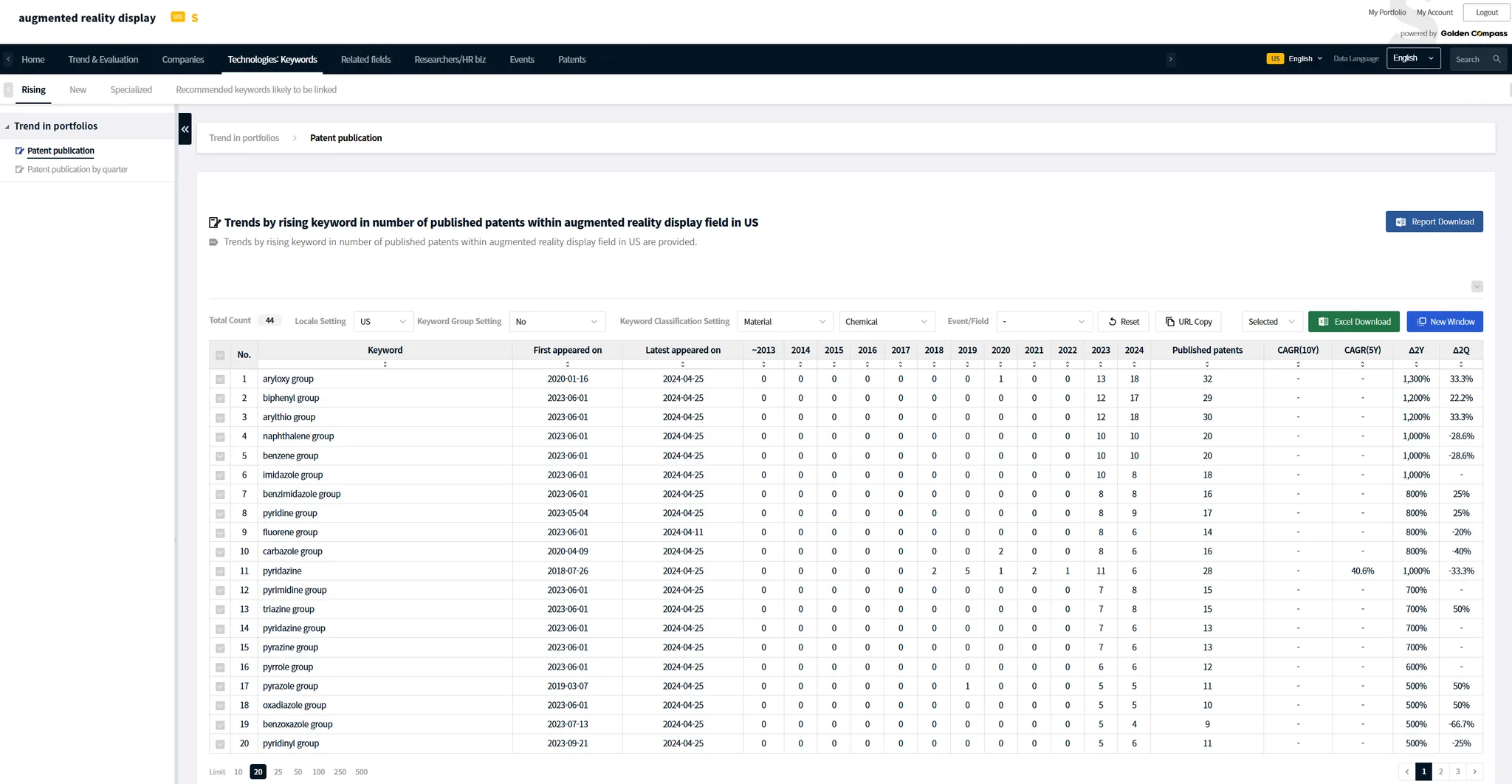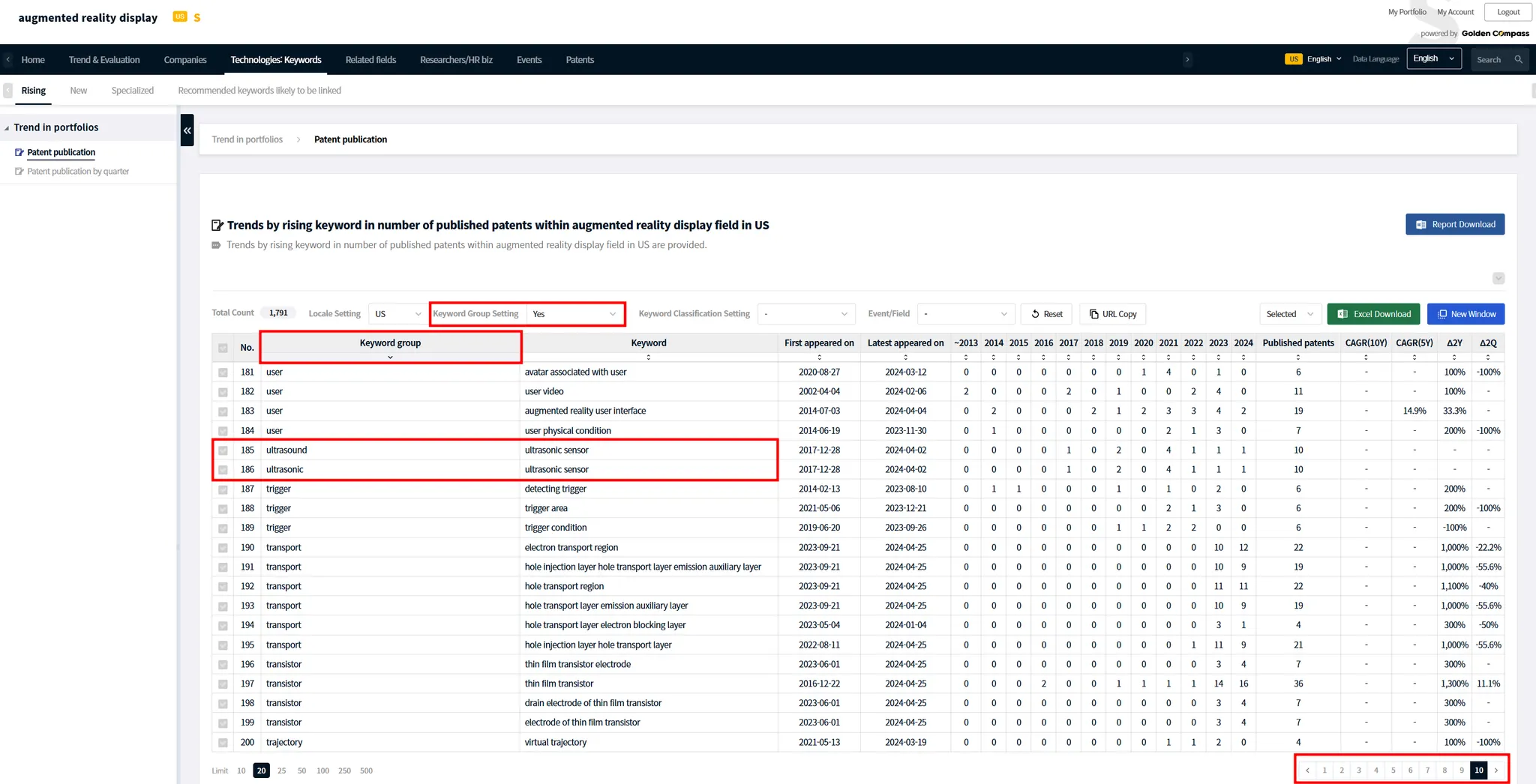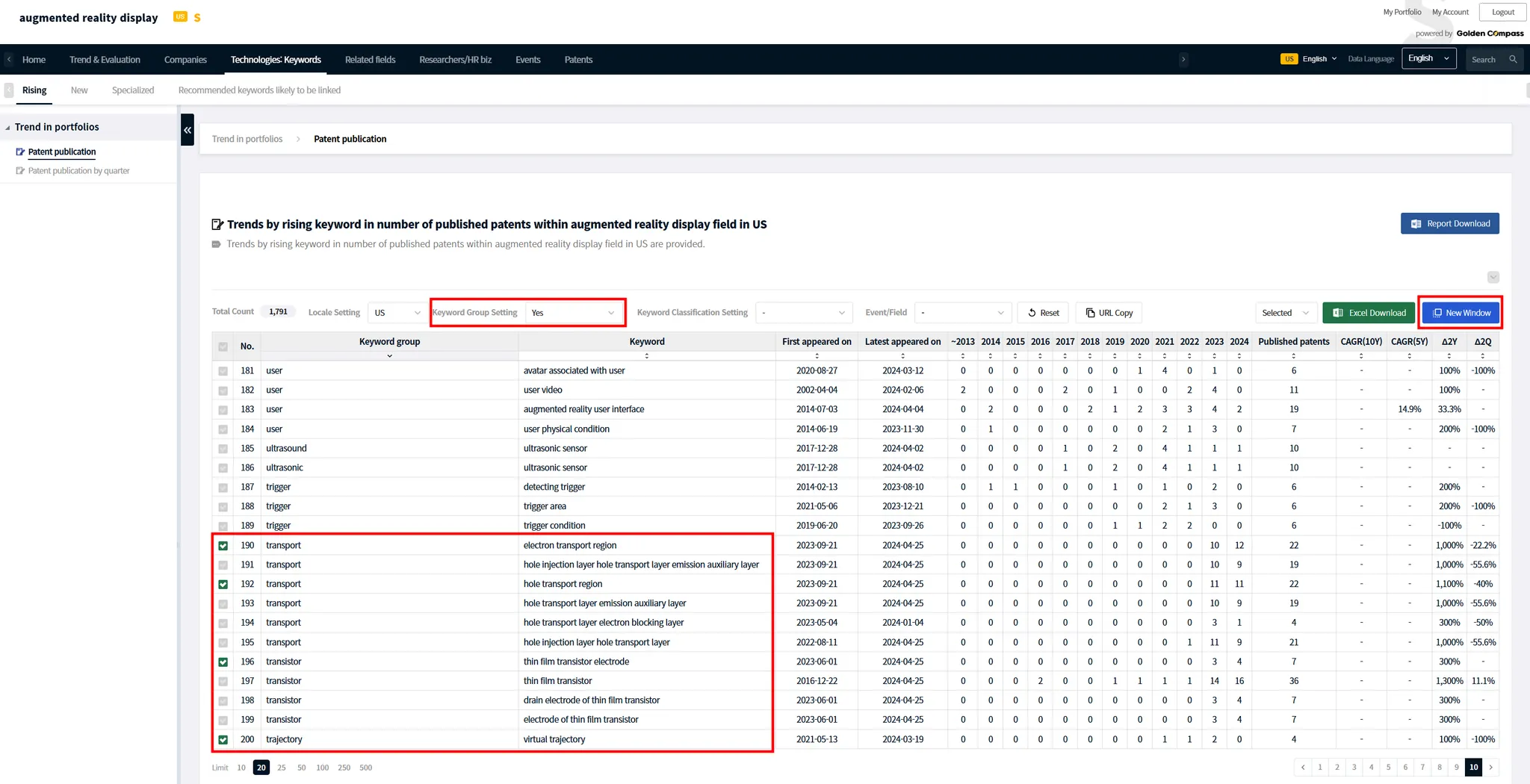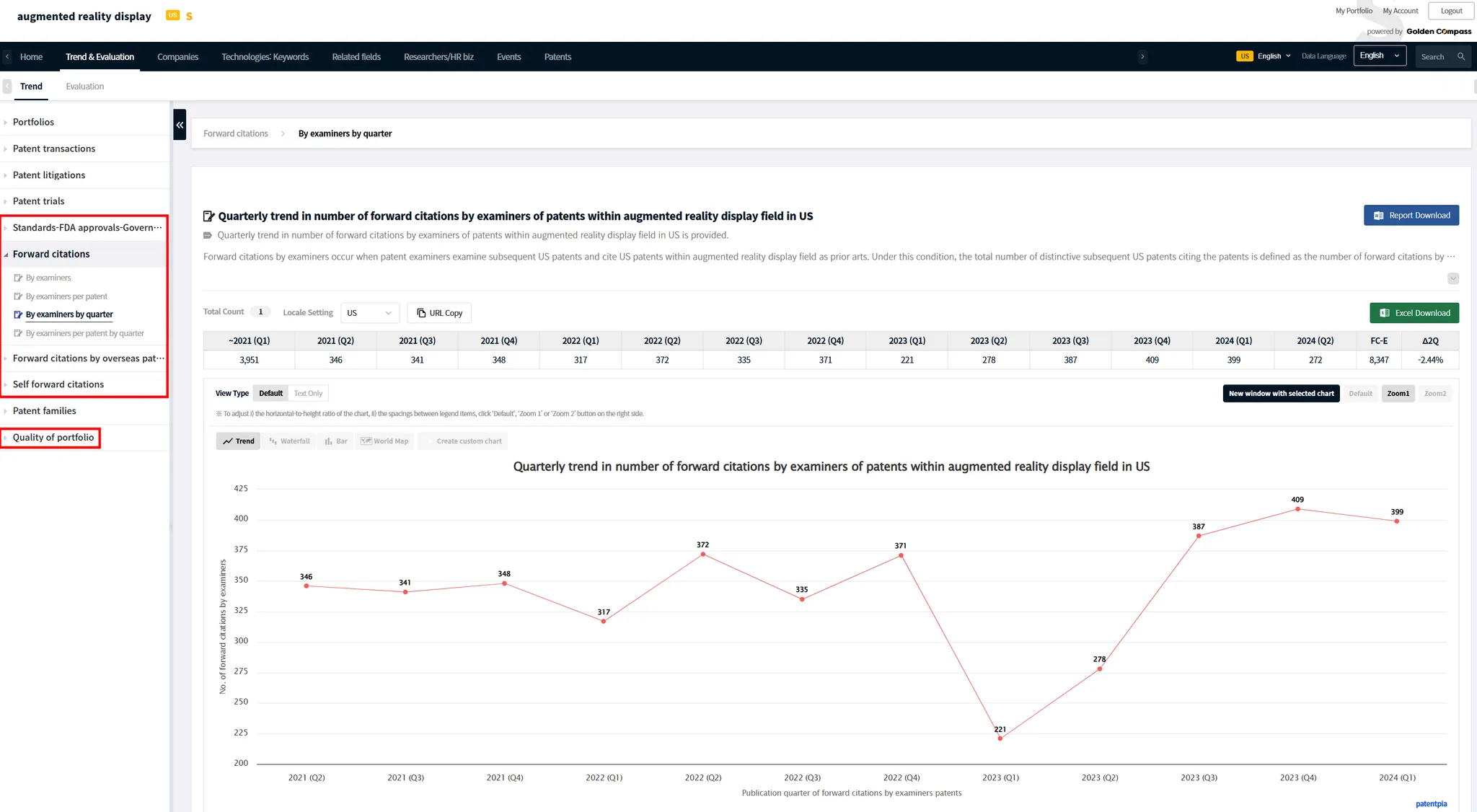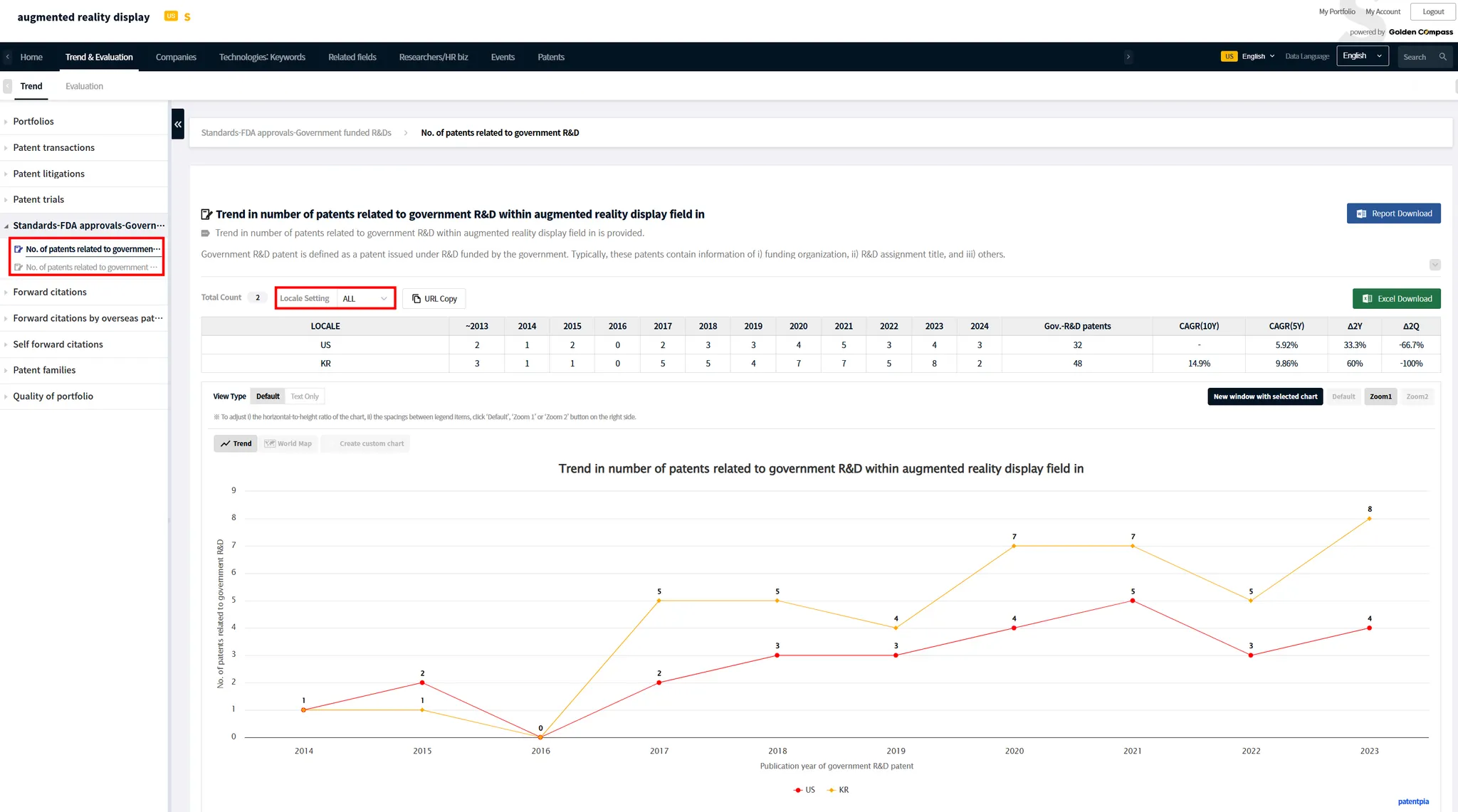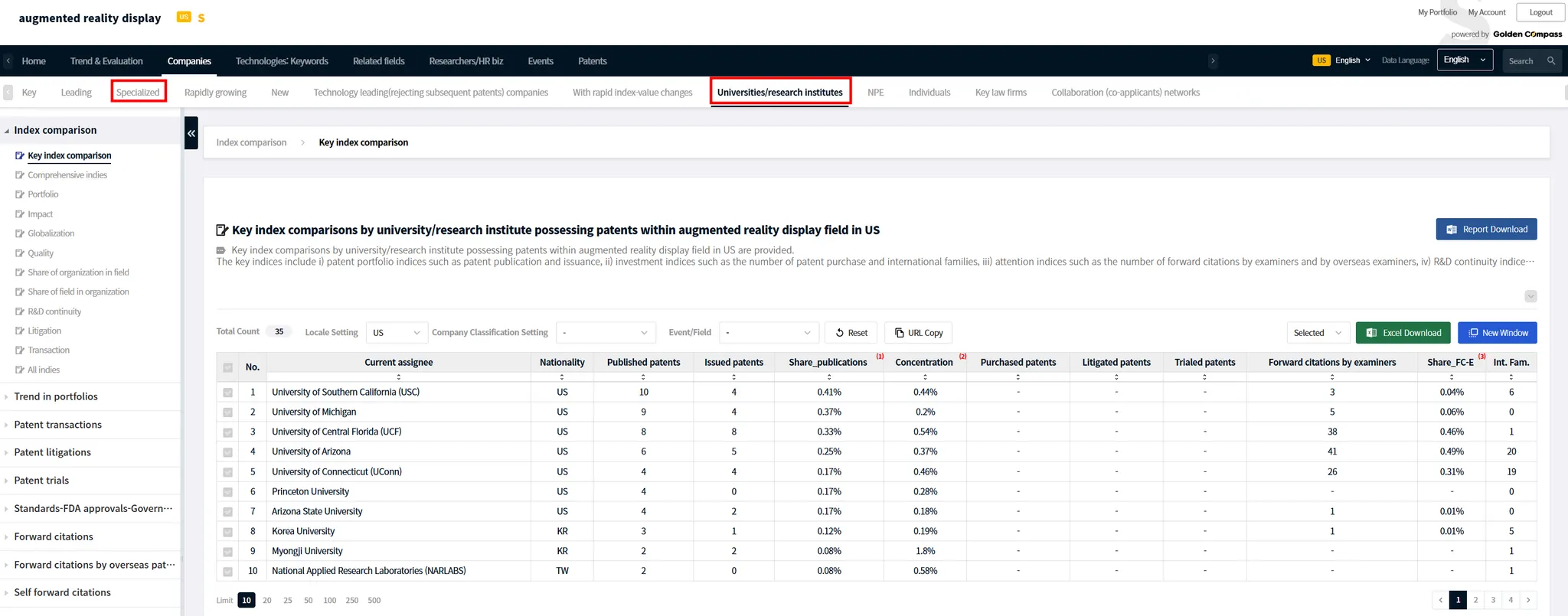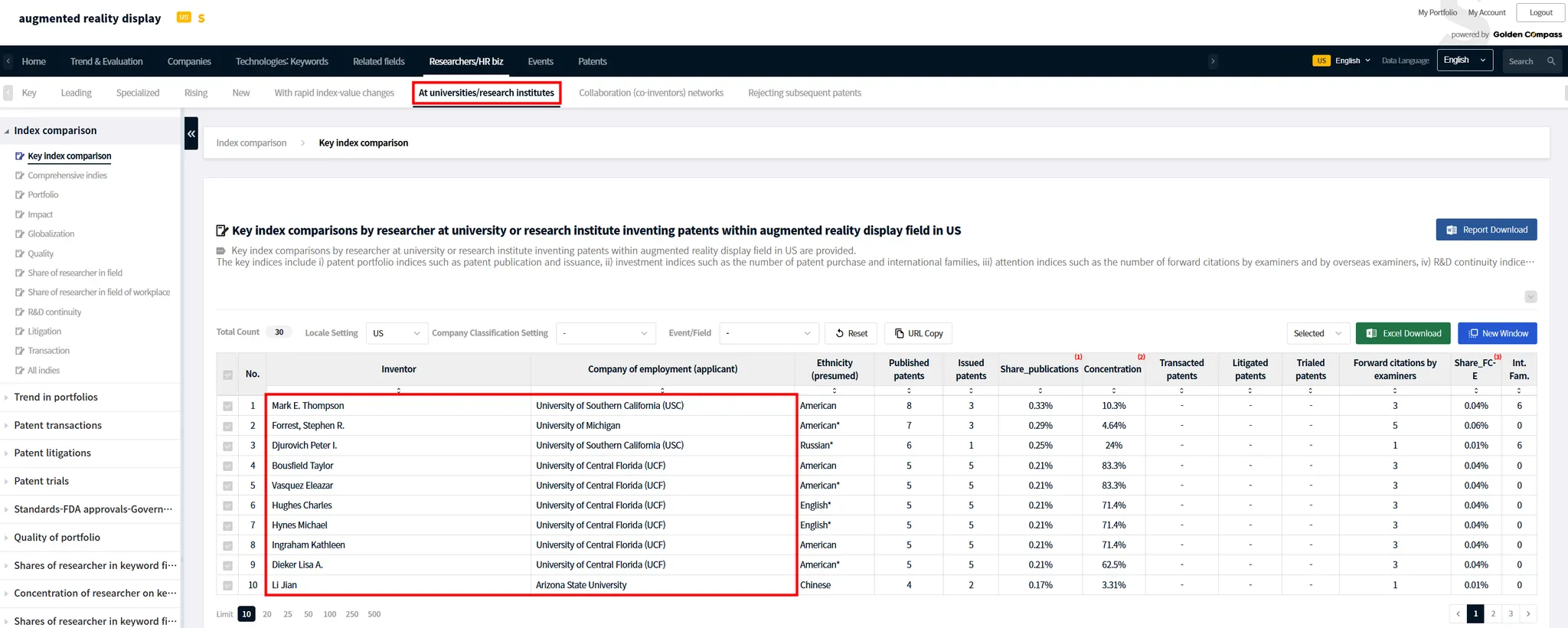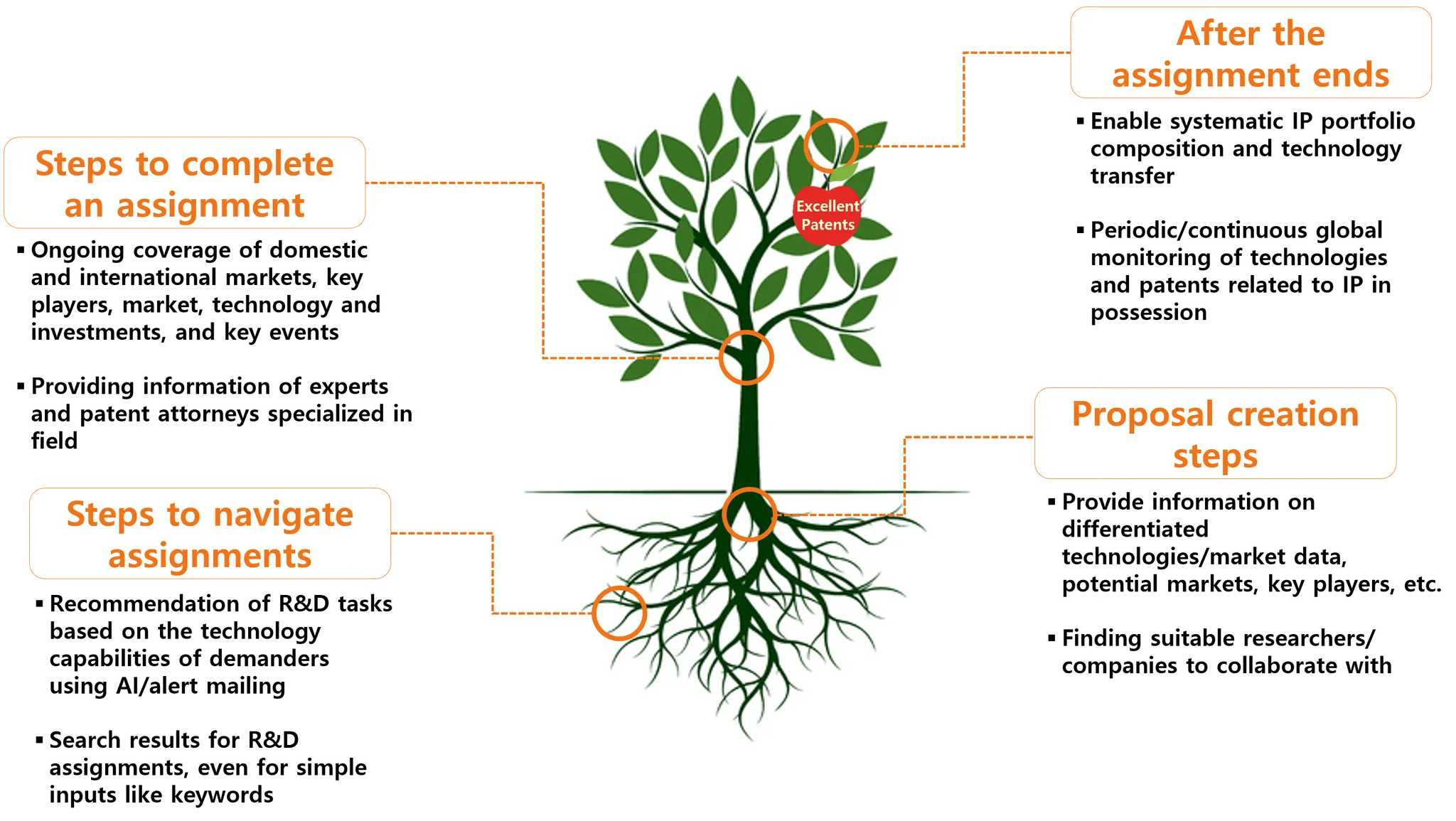Utilization map of making proposals for government-funded R&D projects more competitive
Using the Augmented Reality (AR; AR glass) technology field as an example, we provide contents of making proposals for government-funded R&D projects more competitive via using PatentPia GoldenCompass. If you click on the chain(link) marks that are combined to each item in the above utilization map, the example page will open in a new window.
Scheme of making (government-funded)R&D proposals more competitive
Using the augmented reality display technology field as an example, the contents of making (government-funded)R&D proposals more competitive via using PatentPia GoldenCompass. If you click on the chain(link) marks that are attached to each item in the utilization map above, the example page will open in a new window.
Trend analysis
Points of trend analysis
From an R&D proposal/award support view, the points of the patent trend analysis for my proposal item are as follows.
•
In growing(not mature/contained/declining)
•
Government-funded R&D exists such as US : alignment with R&D investments at the national level such as US, government-funded R&D is preceding private/company R&D
•
Money is flowing : Patent transactions/M&A, patent transfer through M&A
•
Rapidly growing forward citations: utilization/impact
•
Comparison between nations: China, etc. are catching up quickly(need to widen the gap)
Trends in leading nations
Key message : Recent rapid increase in US, a leading nation
Comparison analysis for each nation
Key message : global trends are also increasing
Key player analysis
Key points of key player analysis
•
Market leaders are spending money
•
(domestic)Market leader is entering new markets (anticipating synergy/technology transfer/collaboration possibilities)
•
Market leader/Specialized companies/Core researcher in the newspaper/news is doing something relevant to me
•
Core researcher(e.g., nobel prize winner) is associated with hot/new items
•
Relative vulnerability of domestic companies in key market nations (e.g., US) (paradox of need to supplement/complement/support through R&D)
Identification and position analysis of key players
Key message : presence, position, and patent size of leading companies.
Key message : Samsung affiliates have some influences on market
Marketability analysis
Points of marketability analysis
•
Quick market entry through Buy R&D : Patent purchase / Patent transfer through M&A
•
Money (investment) is moving : M&A and investments in related companies with related items
•
Patent disputes for market preemption/defense : Patent litigations/trials (if there is no food, there is no fight; the role of patents (lawsuits) is to legally exclude latecomers from growing markets)
•
New entrants from domestic large companies/stock price rapidly growing companies/IPOs.
•
Surge in patents related to FDA approvals (used for)
•
Standard-essential patent activity.
Analysis of patent signals that demonstrate marketability
Key message : Recent rapid growth in patent transactions in US. Highly marketable.
Key message : Increase in patenting achievements due to government-funded R&D. Nations recognize importance of this field & supports increasing.
Analysis of utilization/convergence and focus/theme fields
Identify utilization/convergence & focusing/theme fields utilizing co-occurring keywords
Discover the detailed themes of a proposal/planning assignment, or the detailed topics you want to focus on, from the network of co-occurring keywords of its own (input/selected) items. If any of the co-occurring keywords align with the detailed theme or topic, and if there is significant growth for that keyword, it can be utilizationd in the proposal. Also explore surrounding keywords that may directly/indirectly support the detailed theme or topic.
Utilize the filtering feature to explore the network of co-occurring keywords
There are many co-occurring keywords for your own (typed/selected) item, around 1,000-2,000 per nation. You can view them all, but by using filtering, you can effectively narrow down what you want to review/explore.
1.
Use keyword classification
As an example, target co-occurring keywords and extract only “chemicals” from “materials and ingredients”.
2.
Use keyword groups
Keyword groups allow you to collect and explore grouped keywords all at once, especially when the desired word/expression is in the middle of the entire keyword. This is because if your desired word/expression is in the middle of all the keywords, it's hard to find it through sorting. This is especially problematic if your list of keywords is very long, say 1,000-2,000.
Therefore, when searching for keywords against a long list of keywords, it's best to i) group them into keyword groups, and then ii) sort against the keyword group (NOT keyword) field.
Further analysis when you find the right co-keywords
Once you have the right co-keywords, you can do the following additional analysis.
1.
Target analysis for individual co-keywords
When you click on a co-occurring keyword, the clicked co-keyword becomes its own(input/selected) item, and detailed analysis contents are provided targeting the clicked co-occurring keyword.
For example, in the above example, if the keyword “ultrasonic sensor” is of interest, click “ultrasonic sensor”. This will make “ultrasonic sensor” its own(typed/selected) item and open the analysis page for “ultrasonic sensor”.
2.
Analysis for multiple co-keywords of interest
When there are all co-occurring keywords, you can select n co-occurring keywords you are interested in for i) page composition with only selected ones, and ii) keyword comparison analysis(coming soon).
1) Composition of pages with only selected ones
(1) Select interest & Click “New Window”
(2) at “View in New Window” page
2) Keyword comparison analysis (coming soon)
When you click the “Comparison Analysis” button, you will be provided with dozens of comparison analysis contents consisting of only the selected keywords.
Points of analysis in the fields of utilization/convergence and focusing/theme
From the view of discovery in the field of utilization/convergence and focusing/theme, it is good if the specific target utilization/convergence and focusing/theme candidates meet the following conditions, especially if there is a match/synchronization/connection with objective trends.
•
Current keywords for global market-leading companies
•
Keywords from events related to money (investments): patent transfer through M&A, M&A and investments
•
Keywords related to market size/existence: patent litigations (litigation/judgments, no fight if you don't have anything to eat, the role of patents (litigation) is to legally exclude latecomers in a growing market)
•
Keywords related to FDA approvals(patents used in)
•
Keywords related to standard-essential patent activities
•
Rising keywords in patents from government-funded R&D achievements of leading nations
•
Growth : whether or not it is a recent rising/new appearing keyword
Analysis of Technology
From a quantitative view, the analysis of technology can generally be measured by i) Number of citations and ii) No. of forward citations per patent, etc. Furthermore, a patent that receives a high number of citations from important patents and special subsequent patents can be considered to have high technology.
On the other hand, patents that are i) standard-essential patents, ii) patents related to FDA approvals, and iii) patents with rapidly growing No. of forward citations are generally considered to be high technology. On the other hand, i) patents used in litigation/trial, ii) purchased patents, iii) patents with a high No. of foreign patent families, and iv) patents with a high No. of R&D continuity (self-forward citations) within an organization can be considered important patents.
In addition, i) issuance rate, ii) convergence, and iii) independent claim scope retention ratio, which are used to measure the quality of portfolio, can also be utilized in the analysis of technology.
As such, the analysis of the technology of an item can utilize the contents under the “Trends & Evaluation” submenu provided by GoldenCompass.
Of course, the technical analysis of an item is a general technical analysis of an item, i.e., the technical analysis of “my specific item” cannot be made through the analysis of “the item itself”, which is the field/environment in which my item belongs.
Analysis of investments in leading nations
Leading countries (e.g., US, etc.) support R&D through government-funded R&D projects. Patents are applied for and open as achievements of government-funded R&D. Analysis of investments in leading countries is done through analysis of government-funded R&D achievements and patents.
Collaboration-based analysis
Market demands and the technology landscape are changing rapidly. As a result, in addition to the traditional innovation based on in-house R&D capabilities, the importance of connect & development (C&D) or open innovation that utilizes external R&D capabilities is also growing. Such C&D or open innovation is becoming a key strategy for rapid market access.
Analysis of collaboration-based includes i) company/organization-centric analysis, ii) researchers-centric analysis, and iii) analysis of collaboration networks.
Company/institution-focused analysis of collaboration bases includes i) analysis of public R&D entities such as universities/research institutes, ii) analysis of specialized companies, and iii) analysis of networks of overseas researchers (especially those of the same ethnicity). In addition, analysis of i) rapidly growing companies or ii) new companies may also be required.
On the other hand, the collaboration base can also be analyzed by nation.
On the other hand, for private large companies, analysis of the many companies in their domestic and international supply chains, which focus/specialize in items that serve their own purposes, or researchers, may be important.
Technology demand-based existence analysis
The analysis of technology demand base may be different for private companies with a manufacturing/implementation base than for universities/research institutes with no direct manufacturing/implementation. Of course, there are also common checkpoints.
1.
Common cases
•
Market-leading companies' patent investments/expenditures surge Companies: patent purchases/starting or surging domestic and overseas patent applications/registrations
•
Korea-based researchers in leading companies overseas : bridge/collaboration/synergy targets exist in the linked world
2.
For private companies
•
Initiation or surge of investments from current/potential clients (companies along the supply chain)
◦
Patent purchases/licensing
◦
Initiation or surge in patent applications
◦
Rapidly growing patent families with international patent families
◦
Rapidly growing forward citations
◦
Surge in the number of related researchers
3.
For universities/research institutes
•
New entry of domestic large companies/stock price rapidly growing companies/IPO companies
•
Existence of many new companies domestically and internationally
•
M&A/investments in related companies with technology occurred; these companies became companies that can afford to pay/invest.
Special patent analysis
When making R&D proposals or planning, special patents that are worth analyzing related to the proposed/planned items include the following.
1.
Risk related
•
Disputed patents such as patent litigations/patents in trial, etc.
•
Patents in possession of NPEs, etc.
2.
Market/strategy related (especially recent actions of market leaders related to proposals/planning items)
•
Purchased/transaction generated patents
•
Patents transferred through M&A
•
Patents of M&A/investing companies
3.
Related to technology/marketability
•
Standard-essential patents
•
patents related to FDA approvals
4.
Rapidly growing patents (especially for recent patent portfolios related to proposals/planned items from market leaders)
•
Forward citations of rapidly growing patents
•
International patent families' surge patents
•
Self-forward citations for surge patents
Utilizing patent contents throughout the entire life cycle of R&D
Necessity of utilizing patent contents throughout the entire life cycle
There is a high need to utilize global patent data, which is a collection of technology collective intelligence, not only at the planning/proposal stage of R&D, but throughout the entire R&D life cycle.
R&D needs to be adaptively fine-tuned according to market and future demands to maximize the collective utility of i) the R&D outputs, ii) the companies/researchers involved in the R&D, and iii) the supporting/managing organizations/institutions.
In particular, focusing on i) market leader's behavior (patent purchase or patent transfer through M&A, M&A/investment), ii) changes in the risk environment related to disputes such as litigation/adjudication, and iii) new/rapidly growing behaviors or line items of competing companies/organizations/nations/researchers, etc., is necessary to create final outcomes that are in line with the market and competitive environment.
